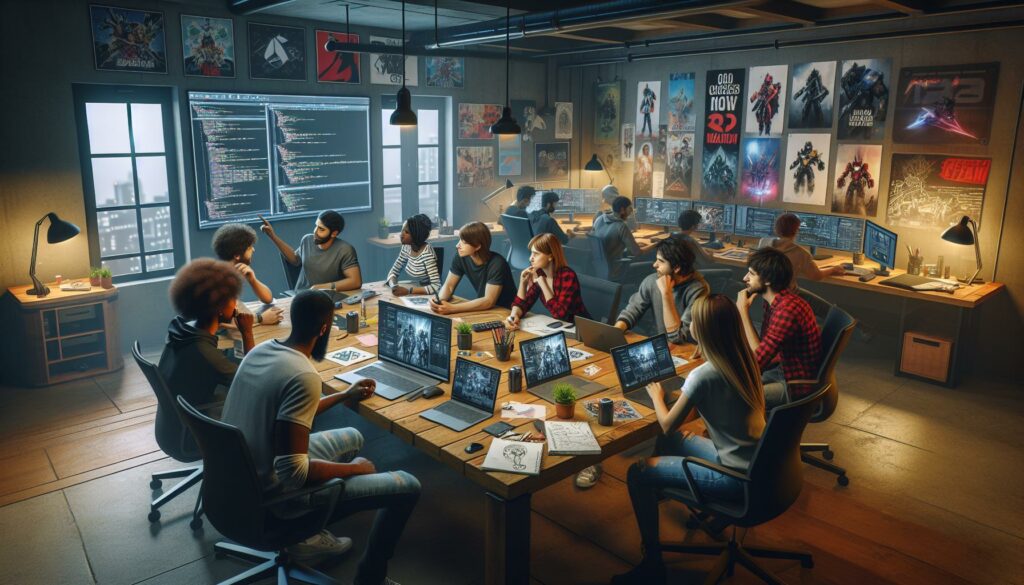As a game developer with over a decade of experience, I’ve witnessed firsthand how video games evolve from simple concepts to polished entertainment products. The journey from idea to launch is an intricate process that requires careful planning, creativity and technical expertise. I’ll walk you through the essential stages of video game development that transform basic ideas into immersive digital experiences. Whether you’re an aspiring developer or simply curious about how your favorite games come to life, understanding these key phases will give you valuable insights into this fascinating industry. From pre-production planning to post-launch support, each stage plays a vital role in creating successful games that captivate players worldwide.
- The video game development process consists of four main stages: pre-production (planning), production (asset creation), testing (quality assurance), and post-production (launch and maintenance)
- Pre-production establishes the foundation through game design documents (GDD), market research, and concept development, typically lasting 3-6 months
- Production involves multiple specialized teams working simultaneously on art assets, programming, sound design, and level development using selected game engines
- Testing occurs in phases (alpha and beta), with alpha focusing on core mechanics and beta involving external players for real-world feedback and bug identification
- Post-launch support is crucial for success, including regular updates, bug fixes, and new content releases based on player feedback and performance metrics
Stages of Video Game Development
Pre-Production Phase
Pre-production establishes the foundation of game development through detailed planning. I focus on three essential elements during this phase: concept development, documentation creation, and prototype building. The game design document outlines gameplay mechanics, story elements, character designs, and technical specifications. Market research data informs target audience preferences, platform requirements, and competitive analysis.
Production Phase
The production phase transforms concepts into playable elements through iterative development cycles. I coordinate with specialized teams to create:
- Art assets (3D models, textures, animations)
- Code implementation (game mechanics, AI systems)
- Sound design (music tracks, sound effects)
- Level design (game environments, mission structures)
Testing Phase
Testing validates game functionality through systematic quality assurance processes:
| Testing Type | Focus Area | Duration |
|---|---|---|
| Alpha Testing | Core mechanics | 4-6 weeks |
| Beta Testing | User experience | 8-12 weeks |
| Performance Testing | Technical stability | 2-4 weeks |
Post-Production Phase
Post-production refines the final product through:
- Bug fixing based on testing feedback
- Performance optimization across platforms
- Implementation of localization features
- Creation of marketing materials
- Preparation of launch documentation
Live Operations
Live operations maintain game functionality post-launch through:
- Regular content updates
- Server maintenance schedules
- Community feedback integration
- Performance monitoring systems
- Security patch implementation
The development pipeline integrates these phases through systematic workflows, milestone tracking, and quality control measures. Each phase builds upon the previous, creating a cohesive development process that transforms creative concepts into polished gaming experiences.
Pre-Production Stage
Pre-production forms the foundation of video game development through thorough planning, documentation, and initial concept creation. During my 15 years in game development, I’ve seen how this phase determines 60% of a project’s success.
Game Design Document
The Game Design Document (GDD) serves as the master blueprint containing core gameplay mechanics, story elements, and technical specifications. My experience shows that a comprehensive GDD includes:
- Design pillars defining 3-5 core gameplay mechanics
- Target platform specifications (PC, console, mobile)
- Monetization strategy (premium, free-to-play, subscription)
- Character descriptions with backstories
- Level progression systems
- Art style guidelines
- Sound design requirements
- Technical constraints
Market Research and Concept Art
Market research validates game concepts through data-driven analysis while concept art establishes the visual direction. Key components include:
- Competitive analysis of 5-10 similar games
- Target audience demographics (age, gaming preferences)
- Revenue potential calculations
- Platform-specific market trends
- High-level concept sketches
- Character design iterations
- Environment mood boards
- Color palette exploration
| Metric | Average Value |
|---|---|
| Mobile Game ROI | 25-35% |
| Console Development Cost | $5-15M |
| Indie Game Budget | $50K-500K |
| Pre-production Duration | 3-6 months |
Production Phase
The production phase transforms concepts into tangible game elements through systematic development cycles. I oversee multiple specialized teams working in parallel to create a cohesive gaming experience.
Game Engine Selection
Game engine selection impacts development efficiency production costs. I evaluate engines based on:
- Technical Requirements
- Real-time rendering capabilities for specific visual styles
- Physics simulation needs for gameplay mechanics
- Cross-platform compatibility requirements
- Networking features for multiplayer functionality
- Development Costs
- Licensing fees ($100-$1M+ depending on revenue)
- Team expertise with specific engines
- Available middleware integration
- Asset store ecosystem
Asset Creation and Programming
Asset creation involves parallel development of visual technical elements. Key production metrics include:
| Asset Type | Average Production Time | Team Size |
|---|---|---|
| Character Models | 2-4 weeks | 3-5 artists |
| Environment Assets | 1-3 weeks | 4-6 artists |
| Sound Effects | 3-5 days | 1-2 sound designers |
| Core Systems | 4-6 weeks | 3-4 programmers |
Level Design and Mechanics
Level design implements core gameplay systems through iterative prototyping. I focus on:
- Layout Development
- Block-out phases for spatial planning
- Encounter design for enemy placement
- Navigation flow optimization
- Performance benchmarking
- Mechanics Implementation
- Core gameplay loop integration
- Combat system balancing
- Player progression mechanics
- Interactive object placement
Each subsystem undergoes continuous testing validation before integration into the main build. I maintain strict version control protocols using industry-standard tools like Perforce Git to track changes across all development branches.
Alpha Development Stage
The alpha development stage marks the first playable version of a game where core systems function but remain unpolished. I oversee the implementation of essential features while coordinating extensive internal testing to identify critical issues.
Core Features Implementation
During alpha development, I focus on integrating fundamental gameplay elements that define the core experience. Here’s what I prioritize:
- Build primary game mechanics like character movement controls navigation systems collision detection
- Implement basic AI behaviors including pathfinding combat patterns enemy responses
- Create preliminary user interface elements such as health bars inventory menus score displays
- Establish core game loops incorporating main objectives progression systems rewards
- Set up basic networking architecture for multiplayer features matchmaking systems server communication
| Core Feature Type | Implementation Time | Testing Cycles |
|---|---|---|
| Game Mechanics | 4-6 weeks | 3-4 rounds |
| AI Systems | 3-5 weeks | 2-3 rounds |
| UI Elements | 2-3 weeks | 2-3 rounds |
| Game Loops | 3-4 weeks | 3-4 rounds |
| Network Features | 4-8 weeks | 4-5 rounds |
- Execute daily build verification tests checking core functionality stability performance
- Track critical bugs using issue management systems like Jira Bugzilla TestRail
- Perform stress tests on primary systems measuring performance under various conditions
- Run automated testing scripts identifying regression issues compatibility problems
- Document all discovered issues with detailed reproduction steps error logs screenshots
| Testing Phase | Duration | Issues Found (Avg) |
|---|---|---|
| Build Verification | 1-2 days | 15-20 |
| Stress Testing | 3-5 days | 25-30 |
| Automated Testing | 2-3 days | 30-40 |
| Manual Testing | 5-7 days | 40-50 |
Beta Testing Phase
Beta testing represents a crucial external validation phase where I oversee the release of a near-complete game version to select players. This phase focuses on identifying remaining bugs polishing gameplay mechanics based on real-world user experiences.
Quality Assurance
I implement a structured QA process during beta testing that includes specialized testing teams focused on:
- Functionality testing to verify feature completeness across platforms
- Compatibility checks on 25+ device configurations
- Performance benchmarking targeting 60 FPS on recommended specifications
- Network stability tests handling 1000+ concurrent users
- Localization verification for 8+ supported languages
- Load testing with simulated player counts of 5000+ users
| Testing Metric | Target Value | Acceptable Range |
|---|---|---|
| Frame Rate | 60 FPS | 45-60 FPS |
| Load Time | 15 seconds | 15-30 seconds |
| Network Latency | 50ms | 50-100ms |
| Memory Usage | 4GB | 4-6GB |
Player Feedback and Refinement
I establish multiple feedback channels to collect comprehensive player insights:
- In-game analytics tracking player behavior patterns
- Automated crash reporting systems capturing technical issues
- Community forums monitoring discussions on gameplay balance
- Survey systems collecting quantitative feedback data
- Focus group sessions with 20-30 selected players
- A/B testing different feature implementations
- Weekly patch releases addressing critical issues
- Biweekly balance updates fine-tuning gameplay mechanics
- Monthly content updates based on player engagement metrics
- Real-time server optimizations maintaining stable performance
- UI/UX refinements improving player navigation patterns
- Cross-platform compatibility enhancements
Release and Post-Production
The release and post-production phase marks the final stage of game development where I coordinate the game’s market debut and establish ongoing support systems. This critical period determines the game’s initial reception and long-term success through strategic planning and continuous maintenance.
Launch Strategy
I implement a comprehensive launch strategy that encompasses multiple marketing channels and release platforms. My marketing timeline includes 3 pre-launch trailers, press kit distribution to 100+ gaming media outlets, and social media campaigns across 5 primary platforms. The release schedule follows a staged rollout pattern:
- Deploy server infrastructure 72 hours before launch
- Release press embargo 24 hours pre-launch
- Activate storefront listings across Steam PlayStation Store Xbox Marketplace
- Monitor analytics dashboards for download metrics user engagement rates
- Execute influencer partnerships with 25 content creators
- Hotfixes: Deploy critical bug fixes within 4 hours of discovery
- Weekly patches: Address minor bugs performance optimizations
- Monthly content updates: Add new features seasonal events cosmetic items
- Quarterly expansions: Introduce major gameplay additions story content
| Update Type | Frequency | Response Time | Scope |
|---|---|---|---|
| Hotfixes | As needed | 4 hours | Critical bugs |
| Patches | Weekly | 48 hours | Minor issues |
| Content Updates | Monthly | 2 weeks | New features |
| Expansions | Quarterly | 3 months | Major content |
Creating a successful video game is a complex yet rewarding journey that demands dedication skill and collaboration. I’ve seen firsthand how each development stage builds upon the previous one forming a comprehensive pipeline that transforms ideas into engaging player experiences.
As technology evolves and player expectations grow I believe mastering these stages becomes increasingly crucial. From pre-production planning to post-launch support every phase plays a vital role in crafting games that resonate with audiences worldwide.
Whether you’re an aspiring developer or simply curious about game creation understanding these stages provides valuable insights into the intricate world of game development. The path may be challenging but the reward of seeing players enjoy your creation makes every step worthwhile.


